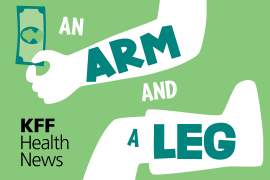The Big News
It was a short work week for those still able to work, but there was a considerable amount of health care news. That hasn’t changed.
The story that probably got the most attention was that the death toll in the United States from COVID-19 passed 100,000 people. It can be hard to get a handle on what that means. The Washington Post looked at the people who count the deaths and track the deaths.
There will be more. The Texas Tribune noted how the coronavirus was a threat to people living in homeless shelters. Nursing homes continue to be a major hot spot in this pandemic. Same goes for areas where poorer people live.
The Reopening
But another source of infections just might be the crowds of people who think all danger has passed and it’s time to frolic in close proximity with others.
You probably saw the photos and video of the crowds Memorial Day weekend in the pool at Lake of the Ozarks, Missouri, or on the boardwalk of Ocean City, Maryland. Missouri health officials pondered how to somehow place the partiers in self-quarantine, but that is unlikely. Cities, states and counties may also play fast and loose with the metrics that indicate when it is safe. The Centers for Disease Control and Prevention quietly removed a recommendation to limit singing in churches. (Singing has been shown to propel saliva particles.) So on it goes.
Disneyland is likely to open in July. Las Vegas casinos also announced their reopening and issued rules. Players can’t touch cards and slot machines will be fewer and farther apart.
Things That Don’t Change
Meanwhile, health care providers continue to find ways to make consumers pay more. The federal government’s Department of Health and Human Services said it will watch for “upcoding” of medical procedures — billing for a more expensive procedure.
We are already seeing it. KHN reporter Phil Galewitz wrote about a large bill for what was supposed to be a free COVID test. (This was not a fluke. We’ve already heard of other similar cases and will be writing about them.)
Drugmakers are also a source of concern. Critics note that the development of remdesivir, a possible COVID treatment, was heavily subsidized by the government, yet Gilead Sciences will be able to place whatever price tag it wants on the drug. Not that what was available went to the right places, The Washington Post reported.
And Stat did an excellent analysis of how there was a lot less to President Donald Trump’s announcement Tuesday about lower insulin prices for seniors. Stat also reported how executives of Moderna, a drug company that reported it was having success with a COVID vaccine, cashed out as the share price soared. The shares have since fallen as investors took another look at the hype.
Well played, Moderna. Well played. pic.twitter.com/oY4pVDOXTa
— John Arnold (@JohnArnoldFndtn) May 26, 2020
And NPR noted a White House staffer with some interesting health care investments.
Toolkits
All of us are looking for ways to measure the epidemic, to quantify it, to find patterns that either agitate or reassure. Here are a few classics and newer ones that I and the staff at KHN found this week.
ProPublica created a quite amazing tool that tracks the companies that won federal contracts related to COVID-19. It helped them develop several very interesting stories about some of those contractors. (Related stories: The federal government’s efforts to get Americans tested for the virus are still failing in myriad ways.)
- A collection of maps and graphics tracking COVID-19
- A model that attempts to measure jobs lost and lives saved
- The Atlantic’s COVID tracking project
- The New York Times’ COVID tracking graphics
- KHN’s updated Pharma Cash to Congress. (Also a good story on newbie Sen. Kyrsten Sinema of Arizona scoring lots of it.)
Stuff You Should Know
For the past couple of weeks, you could hear discussion of “herd immunity” protecting us from the coronavirus bubbling up in conversations on cable TV news shows, on Twitter and among neighbors still observing social distancing. It’s the notion that if enough people are immune from a disease, the few who are not are protected. It’s the basic concept that makes measles shots so important; it protects the young children and vulnerable people who can’t be immunized. It’s why we want a coronavirus vaccine so quickly.
So The Upshot at The New York Times looked at the possibility of herd immunity in a series of tight graphics. Their conclusion: “Even in some of the hardest-hit cities in the world, the studies suggest, the vast majority of people still remain vulnerable to the virus.”
- Here’s a history lesson about the deadly second wave of the 1918 epidemic.
- ABC News explains R0, “R-naught,” and why it is the crucial metric for reopening.
- The San Francisco Chronicle says people with obsessive-compulsive disorder can help the rest of us get through this.
- Reuters reports fewer of us are getting colorectal cancer screenings.
- And last but not least. Masks work: “We now have really clear evidence that wearing masks works — it’s probably a 50% protection against transmission,” said Dr. Chris Murray, director of the Institute for Health Metrics and Evaluation.







